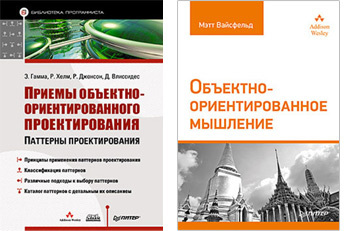Design patterns
Hello habrozhiteli!
We decided to focus on two books that complement each other:

Methods of object-oriented design - E. Gamma, R. Helm, R. Johnson, J. Vlissides
Prototype: Design Patterns. Elements of Reusable Object-Oriented Software
Object-Oriented Thinking - M. Weissfeld
Prototype: The Object-Oriented Thought Process (4th Edition) (Developer's Library)
Abstract: the proposed book describes simple and elegant solutions to typical problems that arise in object-oriented design. Patterns appeared because many developers were looking for ways to increase the flexibility and degree of reuse of their programs. The solutions found are embodied in a concise and easily practicable form. The authors state the principles of using design patterns and provide their catalog. Thus, the book simultaneously solves two problems. First, the role of patterns in creating the architecture of complex systems is demonstrated here. Secondly, using the patterns contained in the reference guide, the designer will be able to easily develop their own applications. The publication is intended both for professional developers and for programmers who master object-oriented design.
Abstract: object-oriented programming is the foundation of modern programming languages, including C ++, Java, C #, Visual Basic, .NET, Ruby, and Objective-C. In addition, objects are at the core of many web technologies, such as JavaScript, Python, and PHP. Object-oriented programming provides the right design techniques, code portability and reuse, but in order to fully understand all this, you need to change your mindset. Developers who are new to the field of object-oriented programming should not be tempted to go directly to a specific programming language (for example, Objective-C, VB .NET, C ++, C #, .NET or Java) or modeling (for example, UML), and instead, first take the time to master what the author of the book, Matt Weisfeld, calls object-oriented thinking. Despite the fact that programming technologies change and evolve over the years, object-oriented concepts remain the same - no matter which platform it is.
For habrozhitelami 20% discount on the whole category Tips for programmers - 4efa3eb4b9f235fe
We decided to focus on two books that complement each other:

Methods of object-oriented design - E. Gamma, R. Helm, R. Johnson, J. Vlissides
Prototype: Design Patterns. Elements of Reusable Object-Oriented Software
Object-Oriented Thinking - M. Weissfeld
Prototype: The Object-Oriented Thought Process (4th Edition) (Developer's Library)
Object Oriented Design Techniques
Abstract: the proposed book describes simple and elegant solutions to typical problems that arise in object-oriented design. Patterns appeared because many developers were looking for ways to increase the flexibility and degree of reuse of their programs. The solutions found are embodied in a concise and easily practicable form. The authors state the principles of using design patterns and provide their catalog. Thus, the book simultaneously solves two problems. First, the role of patterns in creating the architecture of complex systems is demonstrated here. Secondly, using the patterns contained in the reference guide, the designer will be able to easily develop their own applications. The publication is intended both for professional developers and for programmers who master object-oriented design.
Object oriented thinking
Abstract: object-oriented programming is the foundation of modern programming languages, including C ++, Java, C #, Visual Basic, .NET, Ruby, and Objective-C. In addition, objects are at the core of many web technologies, such as JavaScript, Python, and PHP. Object-oriented programming provides the right design techniques, code portability and reuse, but in order to fully understand all this, you need to change your mindset. Developers who are new to the field of object-oriented programming should not be tempted to go directly to a specific programming language (for example, Objective-C, VB .NET, C ++, C #, .NET or Java) or modeling (for example, UML), and instead, first take the time to master what the author of the book, Matt Weisfeld, calls object-oriented thinking. Despite the fact that programming technologies change and evolve over the years, object-oriented concepts remain the same - no matter which platform it is.
For habrozhitelami 20% discount on the whole category Tips for programmers - 4efa3eb4b9f235fe
Only registered users can participate in the survey. Please come in.
Continue book posts?
- 89.9% Yes 376
- 10.5% No 44
- 1.1% I will offer another book theme 5
